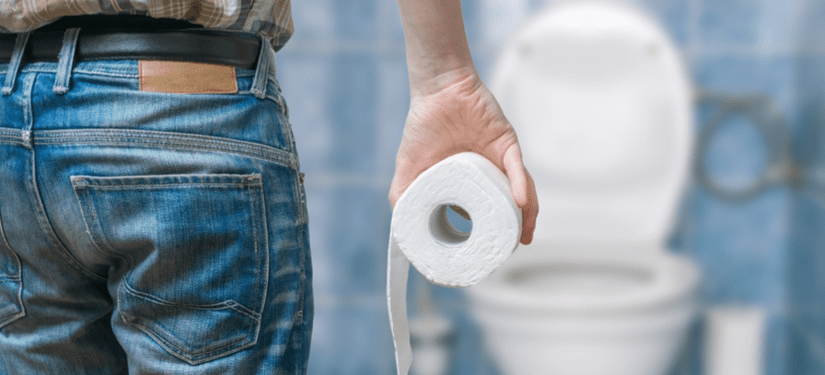If you’re reading this, then you are probably one out of the many Americans-about 63 million people to be exact-who suffer from a constipated gut. Signs of constipation include stools that are dry, hard, and difficult to pass, and occasional bouts of diarrhea due to accumulated feces in the rectum, among others.
Before reading further, you are probably asking: how many No. 2 trips to the bathroom are considered normal, anyway? It pretty much depends on the person’s diet.
After a complete digestive cycle, solid food residue is dumped to the large intestines every one or two days. That means in a week, you should have at least three bowel movements.
But that is not always the case since diets vary from person to person, as well as activities that can contribute to gut motility. For example, frequent travelling can impede the normal rhythm of your gut. Simply put, only you can tell if the frequency is normal to you.
Doctors monitor the normalcy of the bowel movement by checking the quality of the stool and its ease of passage. If it is soft and comfortable to eliminate, then, regardless of how less the frequency, the bowel movement is considered normal.
Constipation can hinder your daily activities especially if it is at its advanced stages. And if not treated, can lead to future problems like anal fissures (lesions in the anus which can bleed open during defecation) and irritable bowel syndrome. How to treat constipation? Here are five tips:
- Drown in water.
Okay, not really. But water is known to help in softening your stool enough to make elimination easy. Hydration is also essential if you have hemorrhoids-a condition wherein the veins around the anus become swollen, causing sac-like lumps in the rectum and anal lining.
While not necessarily harmful, eliminating stools may be difficult since these lumps, when squeezed by the fecal matter during defecation, can bring tremendous pain.
If you hate guzzling gallons of water, you can substitute it with fruits and vegetables that are high in water content. Apples, watermelons, and cucumbers are some examples.
- Bulk up on fiber and-get this-bacteria.
Aside from the water content, fruits and vegetables, PLUS whole grains, can make your bathroom trips more comfortable. That is thanks to fiber.
Fiber is considered to be one of the most colon-friendly substances for humans and animals alike. It helps to increase the frequency and consistency of the bowels which leads to easier passage and a happier gut.
However, studies revealed that the kind of fiber you ingest is crucial-one can make them soft and smooth to pass (soluble fiber), and another can make them bulky (insoluble fiber, recommended for watery stools). Out of all fiber sources, studies revealed that psyllium is the item that can benefit the most.
In battling constipation, consuming both soluble and insoluble fiber is still the safe bet. Males and females must aim to ingest as much as 38 grams and 25 grams of fiber per day, respectively.
Another vital food item that scientists recommend when asked how to cure constipation is to increase your intake of probiotic foods like yogurt, sauerkraut, kimchi, and other fermented foods. The reason is that the good bacteria in them stimulate the gut and intestines to work harder in absorbing food and eliminating them.
To know the right amount, doctors recommend consuming probiotics found in two cups of yogurt daily. But since it is not possible for all of us to eat one (especially the lactose-intolerant), they recommend purchasing supplements instead.
- Strengthen the pelvic muscles.
Although there is some research which recommends that exercise can help in battling constipation, the correlation is not substantial enough. That is why some doctors, while advocating exercising with their patients, claim that it cannot guarantee improvements in your bowel movement. Still, you must exercise-it’s right for you!
On the other hand, some constipated patients find physical therapy exercises that strengthen their pelvic floor muscles are 70% effective in improving their bathroom trips. The program was able to teach them how to contract and relax these muscle groups, enough to keep some patients out of their medications.
- Make it a regular appointment.
Most frequent bathroom trippers, when asked about their toilet habits, said that they take their bowel movements at the same time every day or every other day like clockwork. It is as if their bodies already know that it is time to go.
Since it works for them, why not heed their advice? Start by scheduling your trip in your calendar. Just make sure that it is a time when no one can disturb you-this is essential especially if you share the toilet with someone else.
Studies also revealed that elevating your knees up to your chest (also known as squatting) decreases the stress on the intestines and further stimulate them to eliminate the waste smoothly.
To practice this, have a bathroom stool you can put your feet on as you do your business. The ending position closely mimics the squat.
- Try laxatives-but only as a last resort!
Finally, if all else fails, you can turn to drugs for help. But then again, this tip must only be done as a final option, since your gut may develop independence to medications if used regularly. Establishing habits instead of relying on laxatives is still the most recommended.
You can, however, use laxatives as a springboard or crutch as you start to develop the good habits you need to win against constipation (meaning, the first four tips). And if you can, go natural-plants like aloe vera and senna are common ingredients in laxative products in the market.
Before jumping into conclusions, have a checkup with your doctor and see if you are only constipated or if it is a symptom of an underlying problem, particularly irritable bowel syndrome. In this case, a different approach is needed to eliminate this backdoor problem once and for all.

